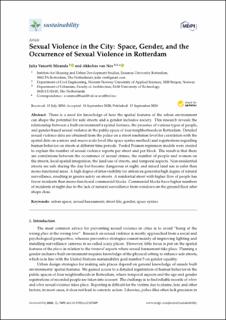| dc.contributor.author | Miranda, Julia Vansetti | |
| dc.contributor.author | van Nes, Akkelies | |
| dc.date.accessioned | 2021-03-11T11:24:13Z | |
| dc.date.available | 2021-03-11T11:24:13Z | |
| dc.date.created | 2020-11-25T13:20:41Z | |
| dc.date.issued | 2020 | |
| dc.identifier.citation | Miranda, J. V., & van Nes, A. (2020). Sexual Violence in the City: Space, Gender, and the Occurrence of Sexual Violence in Rotterdam. Sustainability, 12(18). | en_US |
| dc.identifier.issn | 2071-1050 | |
| dc.identifier.uri | https://hdl.handle.net/11250/2732848 | |
| dc.description.abstract | There is a need for knowledge of how the spatial features of the urban environment can shape the potential for safe streets and a gender inclusive society. This research reveals the relationship between a built environment’s spatial features, the presence of various types of people, and gender-based sexual violence in the public space of four neighborhoods in Rotterdam. Detailed sexual violence data are obtained from the police on a street resolution level for correlation with the spatial data on a micro and macro scale level (the space syntax method) and registrations regarding human behavior on streets at different time periods. Pooled Poisson regression models were created to explain the number of sexual violence reports per street and per block. The result is that there are correlations between the occurrence of sexual crimes, the number of people and women on the streets, local spatial integration, the land use of streets, and temporal aspects. Non-residential streets are safe during the day but become dangerous at night, and mixed land use is safer than mono-functional areas. A high degree of inter-visibility for entrances generates high degree of natural surveillance, resulting in greater safety on streets. A residential street with higher flow of people has fewer incidents than mono-functional commercial blocks. Commercial blocks have higher numbers of incidents at night due to the lack of natural surveillance from windows on the ground floor after shops close. | en_US |
| dc.language.iso | eng | en_US |
| dc.publisher | MDPI | en_US |
| dc.rights | Navngivelse 4.0 Internasjonal | * |
| dc.rights.uri | http://creativecommons.org/licenses/by/4.0/deed.no | * |
| dc.subject | urban space | en_US |
| dc.subject | sexual harassment | en_US |
| dc.subject | street life | en_US |
| dc.subject | gender | en_US |
| dc.subject | space syntax | en_US |
| dc.title | Sexual violence in the city: Space, gender, and the occurrence of sexual violence in Rotterdam | en_US |
| dc.type | Journal article | en_US |
| dc.type | Peer reviewed | en_US |
| dc.description.version | publishedVersion | en_US |
| dc.rights.holder | © 2020 by the authors | en_US |
| dc.source.volume | 12 | en_US |
| dc.source.journal | Sustainability | en_US |
| dc.source.issue | 18 | en_US |
| dc.identifier.doi | 10.3390/su12187609 | |
| dc.identifier.cristin | 1852221 | |
| dc.source.articlenumber | 7609 | en_US |
| cristin.ispublished | true | |
| cristin.fulltext | original | |
| cristin.qualitycode | 1 | |

